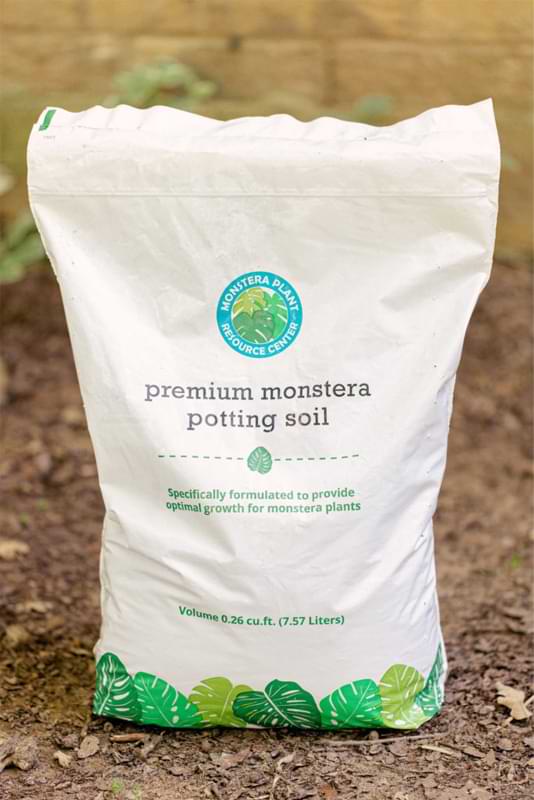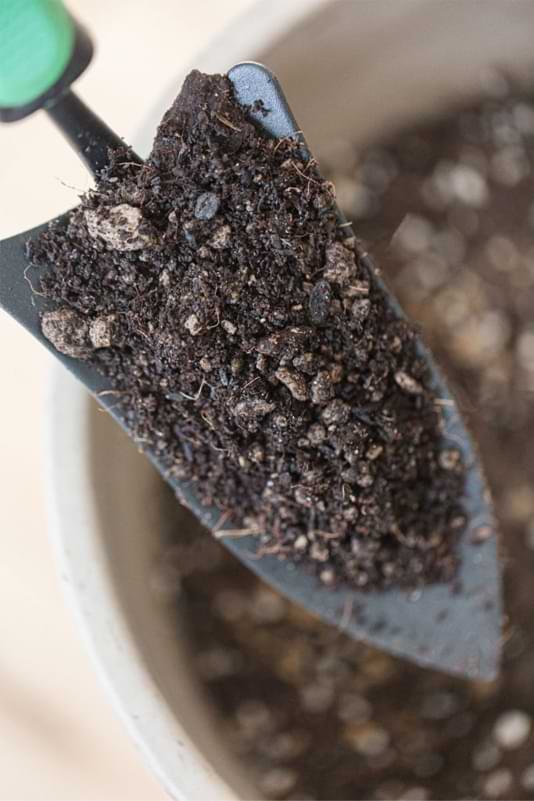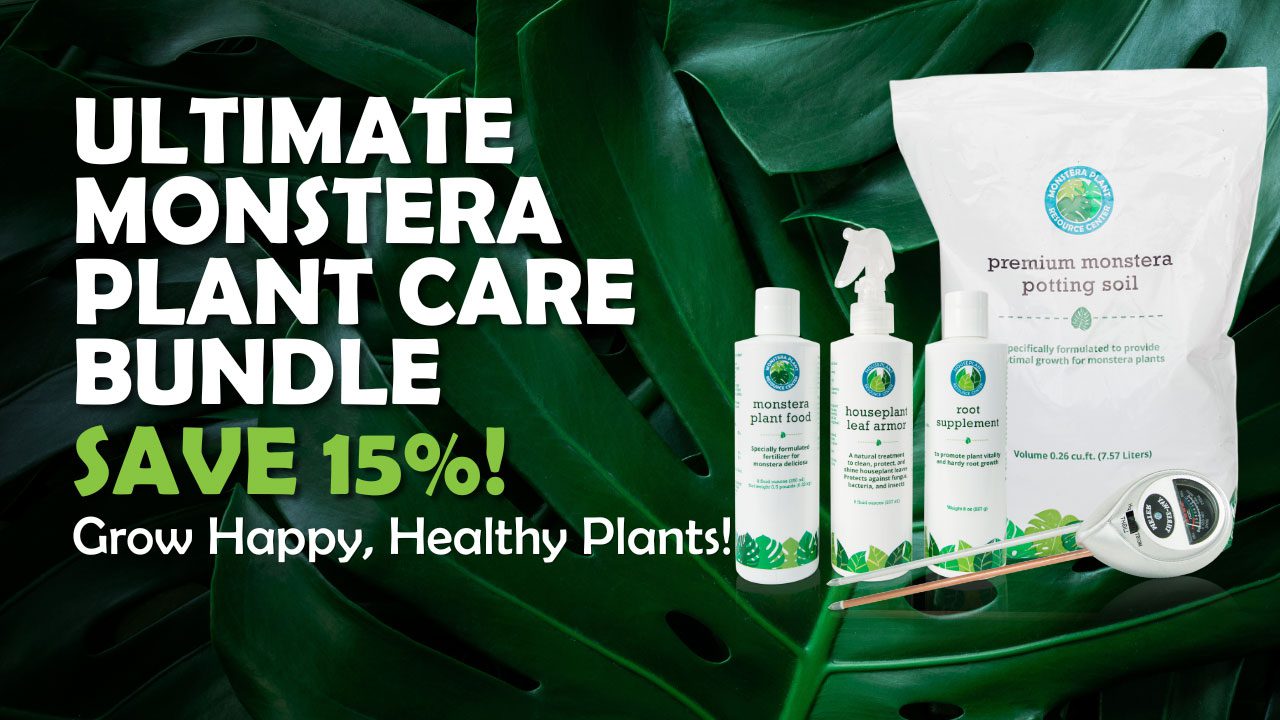Never underestimate the importance of choosing the best soil for monstera plants!
Monstera plants are some of the most popular houseplants around, and they require special soil mixes that are tailored to their needs in order to thrive and give you the best, showiest foliage.
After all, a houseplant’s pot (and the soil inside it) is a huge part of the plant’s environment. This is also where the root structure lives and where it absorbs water and nutrients.
Understanding all the necessary factors and choosing the best soil for monstera plants can be confusing, so keep reading to learn each of these factors. We will even share our favorite ready-made and DIY soils for monstera plants.
Best Soil Mix For Monstera Plants
To choose the best soil mix for your plant, look for a few key ingredients. First, the mix should be well-draining yet still hold moisture – most easily achieved by adding perlite or pumice. Second, it should be rich in organic matter to help support the plant’s rapid growth. A good way to achieve this is by using a potting mix that contains some form of organic material such as compost. Finally, you may also want to add a slow-release fertilizer to the mix to give your plant an extra boost.
A potting mix that is specially formulated for the Monstera varieties will always be your best bet, but you can always make your own potting mixture if you want to go that route, also.
Signs Your Monstera Doesn’t Have The Right Soil
It’s tempting to decide to give your plant whatever potting soil is easiest to grab off the rack, but giving your plant the wrong soil is actually one of the reasons your plant may not be thriving. Here are a few signs to look out for that usually mean your monstera doesn’t have the right soil.
- Yellowing leaves or leaves that are falling off: This is a sign that the plant is not getting enough nutrients.
- Grey or mushy roots: This is a sign of root rot, which can be caused by too much water or not enough drainage.
- Wilting leaves: This could be a sign of too much or too little water.
If you see any of these signs, it’s time to inspect your plant and the soil it is in to determine if it has the right soil. It’s important to adjust the soil so that your Monstera can recover and thrive.

Soil pH For Monstera Plants
Soil pH plays a massive role in your plant’s growth and nutrient uptake, and it can also affect the balance of bacteria in the soil.
This is important because the right bacteria can be beneficial to your monstera, while the wrong bacteria can make your plant sick! And if your monstera can’t absorb certain nutrients (or absorbs too much of others), your plant will suffer from nutrient deficiencies or excess, which can be just as harmful.
The ideal pH range for monstera plants is between 5.5 and 7. They can tolerate a wider range of pH levels, but they will not thrive in very acidic or alkaline soils. If your soil is outside of the ideal range, you can adjust it by adding amendments such as lime to raise the pH or sulfur to lower the pH. You can also monitor your soil’s pH levels by using a pH testing kit .
How To Make Monstera Soil Mix
If you’re a DIY kind of person, you can definitely make your own soil for your monstera plant. Keep in mind that monsteras prefer a moist, well-draining soil that is rich in organic matter. The recipe we’ve included below gives you the perfect combination of organic matter that holds the perfect amount of moisture for your plant.
Monstera Soil Mix Recipe
We love this recipe from Kaylee Ellen on YouTube!
In a large bowl, mix together:
- 5 parts orchid bark
- 4 parts coir
- 5 parts perlite
- 2 parts activated charcoal
- 2 parts worm castings
Instructions:
- Combine all ingredients in a large container and mix well.
- Sterilize your tools and containers before use. This will help prevent the spread of disease.
- Fill your containers with the soil mix, leaving room at the top for watering.
- Water thoroughly and allow the soil to drain before planting your Monstera.
- Then pot your monstera (or any other aroid) in this soil (make sure to use a pot with drainage holes!).
We like this soil because it stays well aerated instead of compacting in the pot, just damp enough to keep your plant hydrated, and it’s highly nutritious thanks to the worm castings (which, by the way, is a fancy way to say worm poop, in case you were wondering).
Soil Moisture
The ideal soil moisture for a Monstera plant is one that is slightly damp to the touch, but not soggy or wet. The best way to water your plant is either right at the soil level avoiding the leaves, or by bottom watering. Allow the top layer of soil to dry out before watering again.
This plant does not like to sit in water, so be sure to drainage holes in the pot are clear and not blocked. If the soil is too dry, the leaves of the plant will start to drop; if it’s too wet, the leaves will yellow and drop. Use a moisture meter to ensure your plant is getting the right amount of water.
Any soil that is specifically designed for monstera plants will retain the perfect amount of moisture for your plant, and you should only have to worry about moisture levels when it’s time to water your plant.
Soil Aeration
Soil aeration is important for monsteras because it helps to oxygenate the roots. This is especially important if the plant is growing in dense, compacted soil. By aerating the soil, you will allow air to circulate around the roots, which will promote healthy growth. There are a few different ways that you can aerate your monstera’s soil:
- Use a garden fork or trowel to loosen the soil around the plant. Be careful not to damage the roots while doing this.
- Mix in some organic matter, such as compost or peat moss. This will help to lighten the soil and improve drainage.
- Place your plant in a pot with drainage holes. This will allow excess water to drain away from the roots, preventing them from becoming waterlogged.
Your soil should be light, not dense, and shouldn’t compact easily. This also allows the roots to grow freely without cramping them in hardened soil. The soil you give your monstera should have plenty of organic matter, so as long as you ensure there are good drainage holes in the pot, your plant shouldn’t have a problem getting the right amount of oxygen to the roots.
Soil Nutrition
Finally, the soil must contain the right nutrient balance for your monstera to promote health and growth. Ingredients like worm castings, compost, and biochar can increase the nutritional value of a soil.
Now, keep in mind that your monstera can burn through all the available nutrients in its pot in a matter of months. In nature, organic matter is constantly breaking down into the soil, which provides a steady supply of nutrients for growing plants. But when your monstera lives in a pot, you’ll need to replenish those nutrients with high-quality monstera food.
Best Ready Mixed Soil For Monstera
Getting the best soil for your monstera doesn’t have to be made at home. There are plenty of ready mixed soils available that are great for your plant. When shopping for your monstera soil mix, make sure to find one that has plenty of drainage and organic matter. The best ready-mixed soil is this premium monstera soil mix.
FAQ Monstera Soil Mix
Can I use orchid soil for monstera?
If you have orchid soil on hand, you may be wondering if it can be used for your monstera plant. The answer is yes! Orchid soil can be used for monstera plants, as it is well-draining, but you’ll want to add some things to it to ensure it retains enough moisture for your monstera. Consider adding some compost, regular potting soil, or even coco coir or peat moss to fix this problem.
Monstera plants need a slightly acidic soil in order to thrive, so make sure to adjust the pH of your orchid soil accordingly. It’s still highly suggested to give your plant a monstera-specific soil, as orchid soils will typically have much chunkier pieces, but it will still work!
Is Loam Soil Good For Monsteras?
Loam soil is not ideal for monsteras because it holds on to a lot of moisture. Loam soil is a type of soil that is a mix of sand, silt, and clay. You can always mix the loam soil with some compost, bark, and plenty of perlite to fix the drainage and aeration, but it might be easier to just go with a premixed monstera soil.
Can I Use Cactus Soil For Monsteras?
Yes, you can use cactus soil for monsteras, but it will not thrive in this soil. It can be used in a pinch if absolutely necessary. Be sure to amend the soil with some organic matter and keep an eye on your plant’s watering needs, as cactus soil can dry out quickly. and does not have much to retain the moisture that your plant will need.
Can I use regular compost for monstera?
Regular compost is great for monsteras! There are some things you’ll need to do before potting your monstera in the compost, though.
First of all, make sure that the compost is well broken down and free from any lumps or clumps. You don’t want to end up with compost that gets moldy inside your monstera’s pot!
Secondly, it’s important to mix the compost with other materials such as perlite or coco coir to ensure good drainage.
And lastly, if you’re using potting mix from a garden center, make sure to check the label to see if it contains fertilizer. If it does, you’ll want to flush it out before using it for your plant.
Other than that, regular compost makes an excellent soil mix for monsteras!
Is charcoal good for Monsteras?
The short answer is yes, charcoal is good for Monsteras! Here’s why:
Charcoal is a type of carbon that’s been charred, or burned. It’s made from wood or other organic materials, and it’s used in a variety of ways, from filtering water to barbecuing.
When it comes to plants, charcoal can help improve the quality of the soil by increasing drainage and aeration while also absorbing excess moisture and nutrients. It also helps to balance the pH levels of the soil, making it more acidic or alkaline as needed.
In addition to all of these benefits, charcoal also contains a variety of minerals that can be beneficial for plants, including potassium, calcium, and magnesium.
Is vermiculite good for Monstera?
Vermiculite is often used in horticulture as a soil amendment or conditioner. Due to its weathering resistance and high cation-exchange capacity, it is an ideal material for incorporation into potting mixes. Additionally, vermiculite has good aeration and drainage properties. As such, it can improve the structure of heavy soils and help with water retention in sandy soils.
In terms of plant growth, vermiculite can help to promote aeration around the roots, as well as moisture and nutrient retention. It has also been shown to improve seed germination rates. Consequently, vermiculite can be beneficial for Monstera plants specifically. However, too much vermiculite in the soil mix can lead to problems with waterlogging, so it is important to use it in moderation.
Repotting Monstera Plants
To repot, you’ll first need a pot that is at least 2 inches wider and deeper than the current pot your plant is in. Second, you’ll need a well-draining potting mix. We recommend using the DIY mix recipe above or the premade monstera potting mix. Third, make sure to water your plant thoroughly before repotting. This will help to prevent any shock from the repotting process.
Once you have all of your supplies gathered, it’s time to start repotting! Gently remove your plant from its current pot and shake off any excess soil. Place your plant in the new pot and fill in around the roots with your potting mix. Water thoroughly and place in a bright, indirect light location.
That’s it! You’ve successfully repotted your monstera plant!
How Do You Know When Monstera Needs Repotting?
You should repot your plant for a few different reasons:
- When you can see roots coming out of the drainage holes
- If the current pot breaks or cracks
- If you suspect root rot
- If your soil becomes hydrophobic
Just keep a close eye on your plant and it should become apparent when it needs a new pot to live in. Repotting is a fairly simple process, just be sure to repot with high-quality soil like the soil discussed in this post and your plant will soon be happy and thriving.






